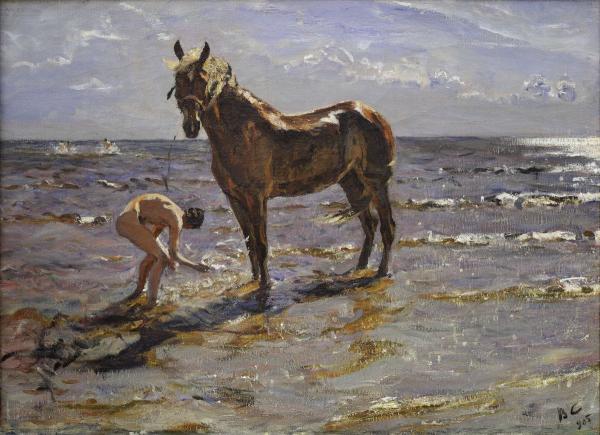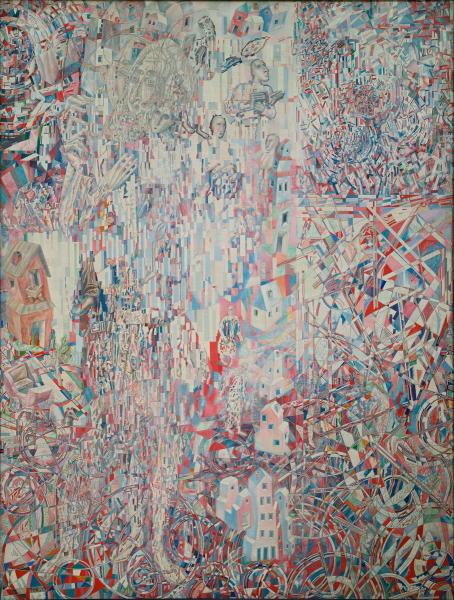The artist is Repin

The repetition of the same name is 1890 is stored in the Kiev Museum of Russian Art; The reduced option of the same name is in the Kharkov Art Museum.
Ilya Repin received an order for the image of St. Nicholas of the Mirliki (Nikolai Wonderworker) from the abbess of the Nikolaev convent in the village of Strelachye Kharkov district. The artist came here to visit his cousin Emilia (in monasticism – Eupraxia). The artist worked on the picture for four years. In 1889, the canvas was exhibited at the 17th TPHV exhibition, where it was acquired by Emperor Alexander III. It was with the purchase of this picture that the decision on the creation of the Russian Museum was connected.
Turning to the life plot of the miraculous salvation of the three innocently convicted by Nikolai Mirliki, Repin not only showed the various psychological reactions of heroes who are on the verge of life and death, but has affected the important problem of religious and philosophical thought of his time-the relationship of faith and reason, spiritual and material.
Repin chose the climax – one moment before death. In the foreground of the canvas – a convicted person chained in shackles. Humility, humility to fate sound in the expression of his face, bowed to his head, gesture of hands pressed to the chest. Nearby is the executioner. The look involuntarily slides over his mighty figure. Clothing of baked blood, a powerful bronze torso, a ferocious face and bewilderment in a look addressed to Nikolai, diverting the sword from the head of an innocent person.
The confrontation of the heroes, their different psychological states Repin concentrates in a peculiar duel of the hands, one – squeezing the sword, the other – it diverts. The tip of the sword as a finger points to two more convicts. Faded by joyful hope, holding out a kneeling old man and a young young man in a translucent tunic, falling from his thin shoulders. God is not from this world, he does not feel death and cannot understand what is happening. His soul is pure and sinless. An almost ethereal figure, elongated vertically and bending like a flame of a candle burning in the temple, is perceived by the antithesis of a powerful bodies of the executioner and is a triumph of spiritual power over a rough unbridled flesh.
Elena Stankevich // Materials for audio guides to the exhibition "Ilya Efimovich Repin". 2019
Read more about the plot (based on the article on the picture on Wikipedia)
The plot of the picture is associated with one of the acts of St. Nicholas the Wonderworker (approximate dates of life – 270–345. e.), which he performed at his time as a bishop in the world of Likiyskaya – a city located in Likia (now this place is located in the territory of the Turkish province of Antalya). It is with the name of this city that the famous nickname of St. Nicholas is associated – "Mirliki".
Being a departure, Nikolai Mirliki learned that the world mayor Eustathius condemned three innocent people, bribed by their ill -wishers. Wanting to stop injustice, Nikolai hastily returned to the worlds and reached Dioscurov Paul, where execution was supposed to take place, just at the moment when the executioner was already ready to start executing the verdict. The Byzantine writer of the 10th century, Simeon Metaphrast described this story in the “Life and Acts of the Holy Father of our Nicholas the Wonderworker”: “When the saint saw this and turned the gaze to a sad sight, then, balance the severity of softness, did not say either a daring or a sharp word, but and did not show any fear or timidity; How much strength he ran to the executioner, boldly grabbed a sword from his hands, and, not fearing anything, threw it to the ground, and freed the convicts from their shackles. No one prevented his autocratic act … ".
It is this moment, when Nikolai the Wonderworker stops the executioner’s sword, listed over the first of the convicts, and was depicted by the artist. The picture contrasts sharply, the adamant of the confident in their innocence of Nikolai Mirliki, the surprise of the executioner, the frightened-vibrant expression of the face of the mayor (“Byzantine courtier”), as well as the figures and faces of convicts, who no longer believed in the possibility of their salvation-“one humble, other perplexing And the third in a fit of crazy hope ".
Although the prototype of St. Nicholas of Mirliki, apparently, was Leo Tolstoy, with whom Repin communicated a lot in those years, the face of St. Nicholas was written with the poet Apollo Maykov. The executioner Repin wrote with the artist Nikolai Kuznetsov. The image of the knee, the image of the writer Jerome Yasinsky, was created, and the puny young suicide bomber, awaiting his turn-from the writer-symbolist Dmitry Merezhkovsky.
The relevance of this topic is close to the moral sermon of Leo Tolstoy and the issue of canceling the death penalty.


